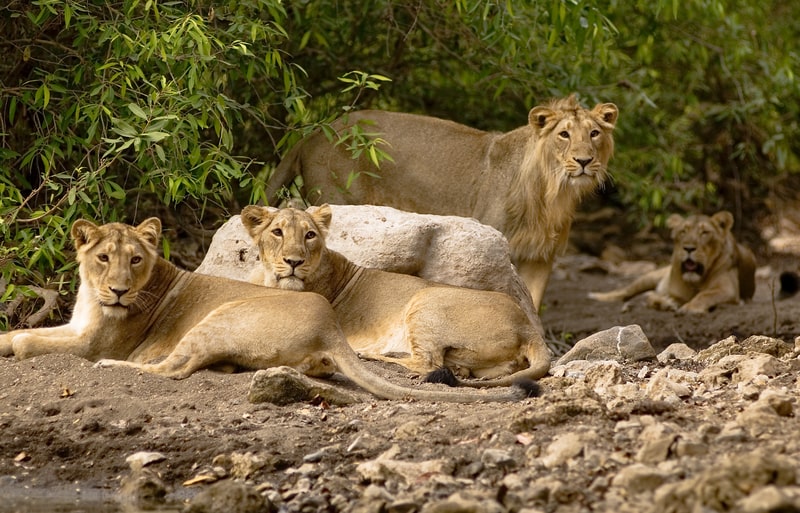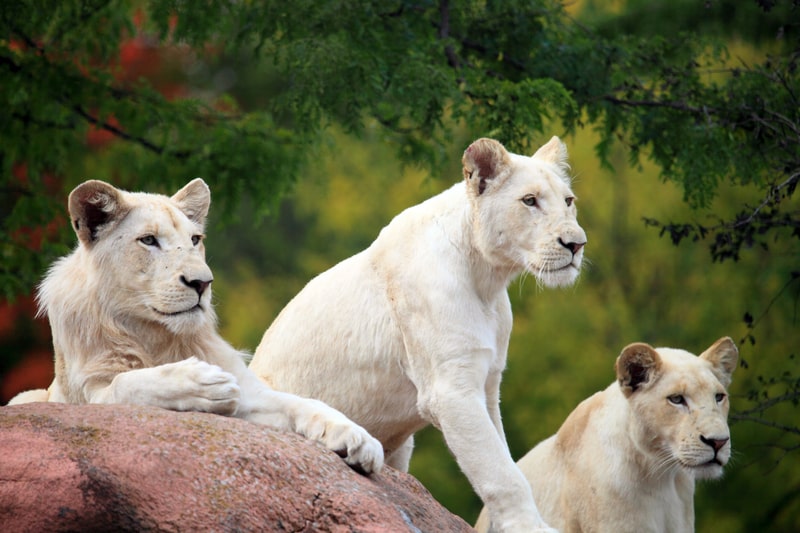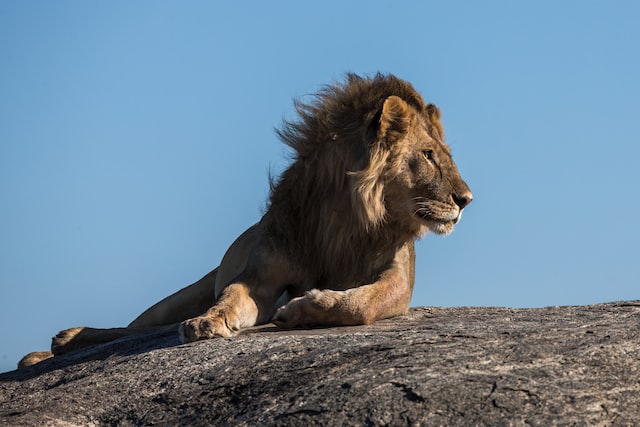Behind tigers, lions are the second biggest cats in the world. Humans have always been fascinated with the power and majesty of lions. We turned them into gods, heroes, and villains. We painted and sculpted their image. Instead of putting lions on a pedestal or marking them as threats, let us get to know them a little better. These creatures have quirks and flaws. They have their struggles and conflicts. Many lions live together to help each other out, but a few have managed to go solo and thrive. With these 58 interesting facts about lions, let us learn more about them.
Facts about Lions
1. Natural Lion Habitats
King of the beasts? Sure. King of the jungle? Not really. Lions rarely enter closed forests, where potential prey can escape up the trees. They prefer open plains, shrublands, and savannahs where their hunting skills shine.
2. The Most Dangerous Land Animal in Africa
This among other facts about lions will surely amaze you. If you see a hippo, run! It is responsible for 500 human deaths each year, making it five times worse than lions. However, these are not the most dangerous animals on the planet. They are no match for the tiny mosquito that causes 725,000 deaths every year.
3. Lion Species
Not much diversity here. Unlike ants and spiders with thousands of species, lions only have one: Panthera leo. However, several sister species existed in prehistoric times, and we know more about them thanks to fossil records.
4. The African Lions
African lions used to stomp all over the continent, even reaching parts of Europe and Asia. Now survivors are scattered around sub-Saharan Africa. Conservationists are working hard to protect the 25,000 beasts remaining in the wild.
5. The Gir Lions of India

Want to see Asiatic lions? Come to the Gir National Park. These are slightly smaller than their African cousins, with a visible skin fold along the belly and a moderate mane that keeps their ears visible.
6. The Cave Lions of Europe
Panthera Spelaea, the cave lion, lived in the frozen regions of Europe, Alaska, and Canada. Our human ancestors lived alongside them around 15,000 years ago. These fascinating creatures inspired cave paintings, clay sculptures, and ivory carvings.
7. The American Lion
It is the largest to walk on Earth, with a size roughly 25% greater than modern lions. Panthera Atrox, or the American Lion, lived between 340,000 to 11,000 years ago, ranging from Alaska to Mexico.
8. White Lions

White lions are not albinos. They are South African lions with a rare genetic condition. It causes pale colors, but their eyes remain unaffected. Among the most famous examples are the white lions of magicians Siegfried & Roy.
9. Lion-Tiger Hybrids
Tigons? Ligers? They have been around since ancient times. Big cats can mate and have babies, but distant habitats and behavioral conflicts make it difficult. Breeders have successful pairings in captivity.
10. A Big but Bad Predator
Male lions are typically 200 kg and two meters long, but this formidable predator is only successful in 20% of hunts (30% in groups). In contrast, the much smaller 1 kg black-footed cat has a 60% success rate.
Facts about lions: their traits
11. Effective Night Hunters

Unlike humans, lions don’t need fancy gear to see in the dark. They are 6x more sensitive to light, so their highly reflective eyes give them natural night vision.
12. Average Lifespan
Lions can have long, eventful lives. Every day is a struggle in the wild, but they can still last for 12 to 16 years. Lifespan can stretch to 25 years in captivity if given abundant food and excellent care.
13. More than Meets the Eye
Two lions with manes mating? It happens a lot in Botswana. Those are not two males, but a male and a maned female. The phenomenon may be due to elevated testosterone or a genetic disposition.
14. Big Hair, Big Expectations
Peacocks have their feathers, and lions have their hairs. A darker, fuller mane signifies an older and healthier male. It is sure to impress potential mates while intimidating other lions.

Testosterone is responsible for this hairy helmet. If you castrate a male lion, it will lose the mane. If a female lion produces excess testosterone, it will grow the coveted status symbol.
15. Other Age Identifiers
Scientists measure teeth length and body size for more accurate age estimates. For example, females are known to achieve two-thirds of their final adult size around their second birthday.
16. Voracious Appetites
Care to have 72 pieces of hamburgers? That is how much lions consume. These big, muscular cats need lots of food to stay fit and healthy. Some eat around 18 pounds of meat per day.
17. Eat All You Can
Lions are not picky. When food is hard to find, they will eat almost anything in sight to survive. These include ostriches and other birds. They could also feast on dead whales that wash up at beaches.

18. Lions have an efficient digestive system
With abundant food, humans can eat around the clock. Lions can only eat when prey is available, which could be once every 3 to 8 days. They maximize each meal with a stomach that can hold over 20% of their body weight.
Acidic enzymes quickly break down meat, while the 7m-long intestine absorbs the nutrients. Digestion remains efficient for as long as they stick to vertebrate food.
19. Why do lions have loose belly skin?
Lions are apex predators that dominate in the survival of the fittest. So, don’t think they are out of shape when you see their loose belly skin. The primordial pouch is a layer of fat present in all types of cats. It protects them from rough playmates, struggling prey, and fierce rivals.
20. Lions and Fiber
Lions love meat. It contains the proteins and other nutrients they need. However, they may occasionally dabble in fruits and vegetables. They also munch on the grass to soothe an upset stomach. Fiber helps them expel fur balls, feathers, and other irritants — an excellent natural remedy for troubled tummies.
21. Pounds per Inch
Which animal has the worst bite? That would be the Nile crocodile at 5,000 psi. Among big cats, the jaguar reigns supreme at 1,500 psi. Lions are comparatively weak at 650 psi, but it is still a lethal bite.
22. Big Mouth

Noisy? Yes. But lions are also big mouths in the literal sense. They can open their jaws up to one foot wide – among the biggest in the animal kingdom. In a circus, lion handlers may place their head inside the mouth for show-stopping act.
23. Lion Tongue
Don’t let a lion lick you! Its tongue is full of tiny spines, also known as papillae. It is rough enough to separate meat from bones. This natural sandpaper would have no trouble removing skin off a human hand. This is one of the intimidating lion facts, at least for their prey.
24. Black Tail Tip

Cubs are born in hidden dens alone with their mom. She’ll teach them the basics and help them gain strength before joining the pride.
They stick to her as much as possible, but it can be hard to follow through tall grass. Fortunately, lions have a black tipped-tail with the perfect height for visibility. This is one of the most impressive lion facts.
25. Super Speed
Lions are sprinters, not marathon runners. They get tired of chasing prey over long distances, so they launch short surprise attacks instead. They can sprint at 50 mph and jump up to 36 feet. It is an effective strategy to catch prey and have dinner with minimum effort.
The Lion Pride
26. Strength in Numbers

It is risky to wander alone in the wild, even if you are a predator. Lions live in groups of 2 to 40 individuals, led by a dominant male and a few other helpers.
27. Role Assignments
Within these groups, females put food on the table while males stay at home. Lionesses do most of their hunting from dusk till dawn. On the other hand, lions remain to defend their territory.
28. Fierce Hunters to Gentle Mothers

It is hard to raise kids, so why not help each other? Female lions often give birth at the same time, and take care of the cubs together. It improves survival and cub health.
29. Longest Gestation Period
Lions have the longest pregnancy among all cats. It can last between 100 and 114 days. Tigers are a close second, with their gestation period lasting between 93 and 112 days.
30. Differences between the Asiatic and African Lion Prides
Size is strategic. Asiatic lions maintain small prides, typically with only two females, since it is easy to subdue their modest prey. Meanwhile, African lions form bigger groups with up to six females. More hunters are needed to take down formidable beasts in their territories.
31. Males and Females in a Pride
African lions are laidback. They don’t mind living with females who aren’t their mates. However, Asiatic lions are not as keen to split scarce resources. You are likely to see them exclusively with female mates, except if they have a large kill and can afford to share the bounty.
32. Cub Life

Cubs are born in secluded dens away from the pride: a cave, a thicket, or some other shelter. After eight weeks, moms will introduce them to the group, and they can begin to annoy the adults with their playful antics.
33. Out on Their Own
Old lions get insecure around young males, kicking most of them out of the pride by age two. Most will perish alone in the wild, but others will form coalitions with other males and survive.
34. Pride Protection

Being the dominant male has its perks: they get first dibs on all the food and mate with the females of the pride. On the flip side, they must defend their territory to the death against other males who want their spot.
35. Pride Territory
Abundance dictates size. If there is plenty of food, lions are content patrolling 8 square miles. If food is sparse, they will wander farther and try to control as much as 150 square miles.
36. Pride Hunting Tactics
Female lions work as a team, and every member has a role. For example, the wings may encircle prey to prevent escape, then drive the animals to the center that initiates the attack.
37. Why Females Hunt More than Males
Male lions are larger but slower. Manes also make their bodies overheat, so they get tired right away. Females are smaller but faster, and they stay cool for longer. It does not happen often, but they may join forces to take down larger prey.
Facts about lions: their unique behaviours
38. Strategic Laziness

Lions figured out the perfect work-life balance: 3 hrs of hunting, 1 hr of eating, and 20 hrs of sleep. Through energy conservation, they can go all-out when attacking prey or defending territory. In their case, it pays to be lazy.
39. Savannah Ninjas
Lions are stealthy hunters. Their light brown coats blend into the savannah, and their padded feet land quietly on the soft grass. Prey rarely sees them approaching until it is too late to escape from the natural ninjas of the savannah.
40. Contagious Behaviors
In the list of facts about lions, this might be a little more surprising and intriguing for you. Did you know that when one lion yawns, others soon follow? The contagious behavior seems to help groups coordinate movements. After this trigger, they may groom, roar, or get up one after another. It is useful when organizing hunts, caring for cubs, and engaging in other communal activities.
41. Ravenous Eaters

Hunger cannot wait. Lions toss table manners aside to eat food before it is gone. Instead of chewing, they tear off chunks and swallow whole, often relying on just one side of their mouth.
42. Lions in the Water
Lions prefer dry land, but they can take a dip now and then. They do it to cool off in the summer, chase prey, and reach the other side.
43. Big Game Hunters

Lions may not be the largest predator in the wild, but they are among the most daring. They hunt much larger animals, such as zebras, giraffes, buffalos, and wildebeest.
. . . continue reading on the next page
